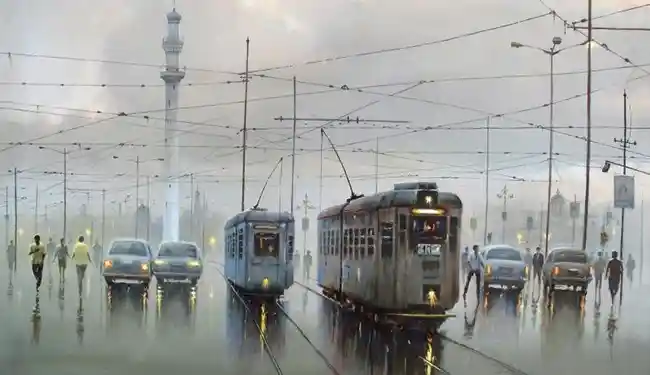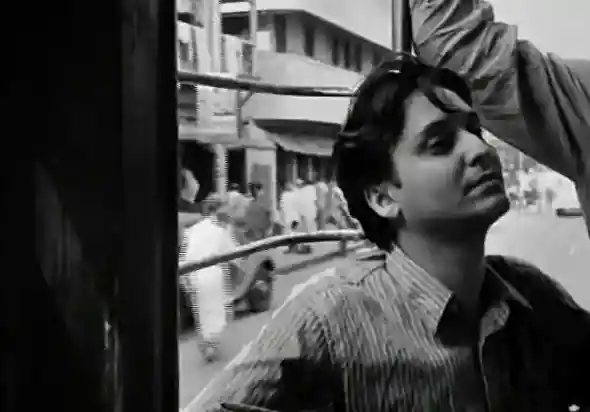The Tram: A Relic of Colonial Calcutta
From being horse-drawn to electrical, the tram has seen a journey of more than 50 years and become an intrinsic part of the Calcutta identity. The city is associated largely with yellow taxis, but a few decades back, the trams that ran through myriad connecting lines across the city’s expanse gave rise to its modern identity. Today, a tram museum near Dharmatala has been built to pay homage to the long-standing but swiftly dissipating tradition of travelling by trams, an image seen in most mid-1900s Bengali cinema.

A train for the roads | Source: Indian Eagle
Modernity arrived at the threshold of Bengal on wheels from the faraway lands of the West. It came in the form of smoke and industry, telegraph poles, palatial residences, and surviving monuments. As the capital city of West Bengal (formerly, India’s) moves away gradually from its colonial Calcutta identity, few of its relics remain in the form of tottering British-era buildings, English street names, and ancient corners of the city studded with tales of the past. Today, yellow taxis appear in popular imagination whenever we think of Kolkata, but long before their advent came the trams - an eco-friendly and sustainable mode of transport ruling the roads of Calcutta since the 1870s.
The streets of Kolkata today, tram or not, still have the old tram tracks laid down almost a century ago. History throbs in the veins of these tracks, embedded in concrete and stone. Sighting a tram today is rare, but not impossible. As the engine wheels past, a passenger on the window seat rests his head against the window and sees life pass by, as in a montage reel. Colourful shops, pedestrians with their laden bazaar bags, an old man peering at a newspaper, friendly political banter between a group of college students - a gateway to the world lay from its window. The popularity of the tram as a transport has considerably declined, owing to the regular bus and metro service provided in Kolkata, but nostalgia and an appreciation of history have kept the Government from completely discontinuing trams.
It is undeniable that tram transport has been witness to numerous historical events, ever since it made its maiden journey in 1873, horse-drawn, between Sealdah and Armenian Ghat street. The event left local people awestruck. The same year, the service was discontinued, and the Calcutta Tramway Company (CTC) was registered in London in 1880, seven years later. After the CTC became a functional body, the original route (Sealdah to Armenian Ghat Street) was laid with meter gauge tracks and it was inaugurated by Lord Ripon, a former Governor-General of India. Trams continued to be horse-drawn, until 1883, when a new route to Khidirpur opened for steam trams. It was in 1902 that the electric tram made its first journey between Esplanade and Khidirpur, and services were introduced from Esplanade to Kalighat. Hence, began the period of popularity for tramways, with 37 lines in its network. It connected different zones, truly exuding the spirit of oneness brought about by tightly-knit transportation and communication. Tramways were reliable and punctual and were largely used by women and the elderly. It also served various purposes like a route from Sealdah Station to Howrah Bridge (now Rabindra Setu) via Harrison Road (now Mahatma Gandhi Road) was opened next year, for serving the businessmen, residents, ferry passengers and railway passengers for Howrah Station.

Soumitra Chatterjee as 'Apu' on a tram in Apur Sansar (1959) | Source: The Wire
This rising popularity was eclipsed by the influx of East Bengal refugees in West Bengal; the population was rising and with it buses and cars. It was getting increasingly difficult for trams to compete with the newer modes of transport because their necessities for proper functioning were manifold. By the 1930s, trams were already declining. By the 1980s, maximum routes were shut down. Trams were discontinued in all the major cities of India, except Kolkata due to the efforts of Rabin Mukherjee, the then Transport Minister. From 1990, financial losses outnumbered the gains, and mass closures of tram depots started. Today, five depots are still running, namely Kalighat, Tollygunge, Gariahat, Rajabazar, and Khidirpur. Trams may not be visible frequently on Kolkata roads anymore, but the depots still have several trams for the public's view. Several tram museums have been built to carry the legacy forward and inform the people of Bengal about their rich past. One such is near Dharmatala itself, built inside a tram. The limited space, with two carriages, has been transformed into a small museum on one side full of pictures, mementoes, and relics, and the history of Kolkata tramways is brilliantly illustrated. One has to pay a nominal amount of 20 rupees to tour the museum. If you ever find yourself in the city, don't forget to visit the place that carries a history worth 150 years!


